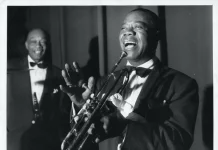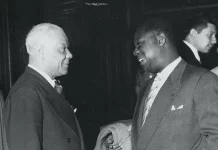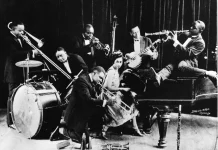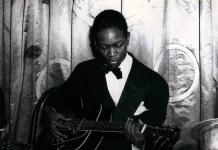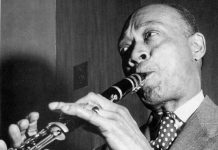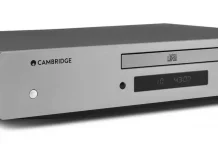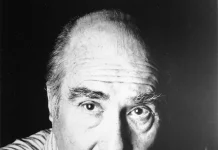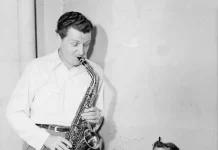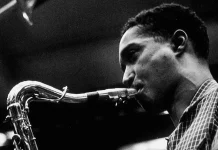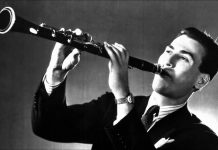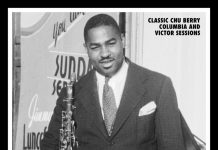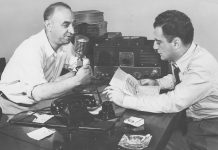Art Blakey grew up in Pittsburgh, one of the toughest cities, during one of the hardest times endured in America. During his childhood and youth he lived through a nightmare life that none of us today could imagine.
“All my family were musicians except my father and my father hated musicians. But I didn’t know who my father was until I was 15 and I got ready to get married. I had two chicks knocked up and I had to get married right away or go to jail, as you had to in those days in Pittsburgh. So he had to sign for me and that’s when I found out he was my father. I used to see him almost every day, and didn’t know he was my dad. He lived to be 103. My mother died when I was six months old.
Big Sid Catlett: ‘Son, when you’re in trouble, roll’
“I played jazz on account of survival because I didn’t like to work in the mines. They had child labour then and I worked in coal mines and steel works. People living under bridges … the dust bowl, selling apples, hungry people. It was dog eat dog in those days. When I should have been an adolescent I was a man. At the age of 14 I had a family and at 15 I was a father. I never had a childhood.
“I played piano for a while. I used to bang on it by ear, but I couldn’t play good enough, only two or three keys. I had my first professional engagement while I worked in the steel mills. It was at a little club called the Ritz in Philadelphia playing piano – I had a little band in there.
“Then I met Erroll Garner and he sat in at one of my rehearsals. I was working for a gangster who always wore a big pistol. When the gangster heard Erroll he told me it was time I learned to play the drums, so that’s what I did. Erroll took over at the piano and that was the end of my piano-playing days.”
Art’s big influences were Big Sid Catlett and Chick Webb. “Chick brought the drums from the back of the band down to the front as an instrument of equal value to the horns and piano. Sid Catlett was a master of dynamic, he had finesse and a fantastic technique. “‘Son,’ he told me, ‘when you’re in trouble, roll.'” Over the years Art developed a press roll which spoke volumes to his band, signifying many things, but at its most forceful telling a recalcitrant soloist to stop playing.
‘We travelled through the South all day and had a pocketful of money, but couldn’t get a glass of water, And if you did they’d sell it to you a dollar a glass. And it would be hot as panther piss’
After a period with Mary Lou Williams, Art Blakey joined the Fletcher Henderson big band in February 1943 and stayed for a year. He was on the notorious tour of the South that the band made.
“We travelled through the South all day and had a pocketful of money, but couldn’t get a glass of water,” he remembered. “And if you did they’d sell it to you a dollar a glass. And it would be hot as panther piss.”
Art joined the newly formed and era-changing Billy Eckstine band in 1944, undoubtedly acquiring fundamental elements of his playing under the influence of fellow sidemen Fats Navarro, Charlie Parker, Gene Ammons, Dexter Gordon, Kenny Dorham, Dizzy Gillespie, Miles Davis, Sarah Vaughan and Lucky Thompson. Tadd Dameron was in the band as an arranger.
“The Jazz Messengers really started in 1949,” said Art. “But then it was called the 17 Messengers. The cats that put the band together came to me and told me I was going to be the leader. Being a musician has nothing to do with being a leader. I was a good organiser. That’s always been my talent. The 17 Messengers was a good band. There were a lot of great players in it like Sonny Rollins and Bud Powell. We were just playing around New York making a few gigs. But economically the band was a disaster, so we had to break it up.”
The 50s was one of jazz’s golden decades. It’s generally thought that this was because of the emergence of hard bop, but the name, irrelevant anyway, didn’t emerge until quite late. More important was the metamorphosis of Miles Davis from the heady triumph of his 1949 band into a much in-demand leader of “all-star groups” that regularly employed and nurtured emergent youngsters, including Blakey, who were to proliferate the new style. Most effective of these young men was one Horace Ward Martin Tavares Silver.
Horace Silver was in his early 20s when Stan Getz heard him playing in a club in Hartford, Connecticut. Stan, at a similar age, immediately hired him and Horace followed Al Haig in initiating the phenomenal line of jazz pianists that worked for the tenor player.
Such strength of talent was not to be corralled and Silver soon moved to New York to freelance, taking five months out to back Lester Young. After this he formed his bond with Blakey and the two ran a quintet together. Clifford Brown played and recorded with the quintet in February 1954. He made up the front line with altoist Lou Donaldson for what made two exhilarating CDs, issued as A Night In Birdland. The session was described as by Art Blakey’s Quintet, but was probably by Horace Silver’s. The evening at the club was introduced by the notorious and very short Birdland MC Pee Wee Marquette. Marquette would blackmail the artists, adjusting the fervour of his enthusiasm upwards or downwards depending on how big a back-hander he was given. He tried it on Lester Young, who was not impressed.
“Listen, half a mother-fucker”, he began his refusal…
‘I saw people give Clifford Brown golden trumpets, silver bells, everything. They wanted him to advertise for their companies. He just went down the line and tried them all, but in the end he put them down. He played this old trumpet’
It appears that only the first of the two CDs (on Blue Note 72435 32146) is still available. The success of the Birdland albums – unrehearsed and improvised as they had been – prompted Horace Silver to organise the group properly and it was then that he came up with the name the Jazz Messengers.
“We started the group with Kenny Dorham, Horace, Hank Mobley and Doug Watkins,” Blakey said. “It started and just kept going. I knew if I had problems the guys who had left would come back and help me till I found someone new.”
Blakey decided early on that he would only use young, fresh musicians, and that remained the guiding tenet of the Messengers. The list of his youthful discoveries resonated over the next 36 years and into history.
Over the years Blakey developed a drum technique that almost vocalised the instrument. He used every bit of his drum kit in a way that no one had ever done before and he could almost literally make it talk. He had no time for flashy equipment and used only a rudimentary kit.
“I use anything I can get. Do the best you can with what you have. That’s what it’s all about.
“Charlie Parker often didn’t have a horn and he played whatever they had. They even gave him a plastic horn once, and he still sounded like Charlie Parker. I saw people give Clifford Brown golden trumpets, silver bells, everything. They wanted him to advertise for their companies. He just went down the line and tried them all, but in the end he put them down. He played this old trumpet. I think it was called a Blessing, and that’s what he was buried with, that horn.”
From autumn 1954 until the end of 1955 the classic first front line of the Jazz Messengers held sway. For some reason Silver broke the partnership and left in the spring of 1956 and went his own way, leaving Art to front the Jazz Messengers.
Very occasionally you’ll find an album by the Jazz Messengers which is not very inspiring. But that doesn’t happen often, and the bands left a huge body of music which, considering the number of young men involved, is remarkable and rarely falls below outstanding. Blakey’s name is one of the most reliable guarantees.
So there are few pitfalls in the music, but one must be careful in the quality of the CD issues. As a general rule, it’s worth buying original Blue Note issues where possible. In some cases any fall below Blue Note standards can be insignificant, as with the otherwise impeccable Complete Studio Recordings by the Morgan, Shorter, Timmons band on Jazz Dynamics 009 (four-CD, 52 tracks). The excellent value Quadromania – Horace Silver Down Home – 222477-444 – has Art with Horace on most of its tracks (Art’s only on five tracks of the otherwise desirable Blue Note Silver Retrospective four-CD set). The Avid issues that have four albums by Art on each are terrific value and have high-quality sound for budget albums. The one on AMSC1017 has the benefit of Art’s big band that immediately preceded the Messengers. It features solos by John Coltrane, Sahib Shihab, Frank Rehak and Jimmy Cleveland as well as Art and others. Art Blakey’s Jazz Messengers With Thelonious Monk on Atlantic (Japanese 8122-79598) is a jazz milestone.
One of the hottest and most turbulent standbys for the Messengers is their chart of It’s Only A Paper Moon. It usually ran for something over 12 minutes and showed off the quintet to perfection. All the versions of it that I’ve heard are good, but the one on Swiss Radio Days TCB 02062 sizzles and burns to perfection. It must be hard to get by now.
Appropriately, since it came at the peak of Art’s career, the group with Lee Morgan and/or Benny Golson or Wayne Shorter is regarded as the high point of the Messengers. The early groups with Silver were also outstanding, but the ones with Morgan were noted for their unfailing consistency over a long period.
Golson was a key man. Blakey groups were shambolic until he joined in 1958, and he pulled the band together, enforcing punctuality and discipline on the stand and also writing some of the most potent and permanent parts of the library, including Along Came Betty, Are You Real? and Blues March. Both tenor players were highly commendable and which you prefer is a personal matter. It must be recognised that Shorter moved into the band after Golson had established the bedrock for him. But Shorter was every bit as much a giant, as Blakey made clear.
“Wayne Shorter is one of the most brilliant musicians I know of who have come along in the past 20 years. He is something else. He’s well-educated and he has degrees. He was something. When John Coltrane left it was supposed to be Wayne Shorter. He could have stepped in right there. I saw what was happening, because his personality was smothered when Lee Morgan and Bobby Timmons were in the band. I had to let them both go and hire Cedar Walton and Freddie Hubbard and make Wayne the musical director to make him push out, and he really came out of it. But then he left the band and went with Miles Davis. I don’t know what for. I knew his personality was going to be smothered because Miles is a different type of person. He’s a star and he’s himself and he doesn’t need anyone.”
There’s a very attractive 2-CD set by the Morgan/Shorter group that came out fairly recently. It’s called First Flight To Tokyo (Blue Note) and was recorded on the first trip to Japan in 1961 when the whole population seemed to go mad with Blakey fervour. The album has received plaudits in every aspect, but to me it sounds as though the two horns are off-mike (it’s a high-grade amateur recording). No matter, for if ever there was a brilliant drum album, this is it. The opening track, Now’s The Time, opens with a five-minute drum solo which might sound off-putting, but in fact it is totally absorbing, and a masterclass in Blakey’s almost vocal communications through his kit. There are more drum solos too, and they are equally compelling. Some idea of the impact of the performance can be gleaned from the fact that when the first house concert ended and the sidemen went to their dressing rooms, Blakey remained seated at the drums crying, overwhelmed by the audience reception.
After the peak in Lee Morgan’s days with the band, Art went on to have many more versions of the Messengers. As always his musicians were accomplished but none, except possibly the Marsalis brothers, approached the earlier quality.
Fortunately the key ones of Blakey’s multitudinous recordings (most not dealt with here) are still available. But they need a separate essay on their own.
It’s uncomfortable to end on a sad note. Throughout the Messenger years Art was comfortable with his heroin addiction, and, not only did he fail to discourage the habit amongst his young men, but it seems that he actively encouraged use of the drug amongst new members.


